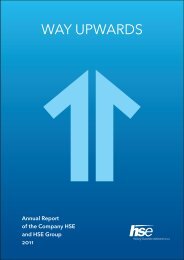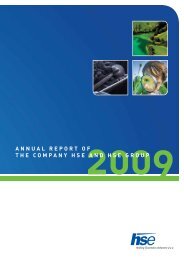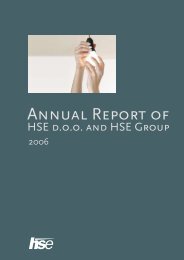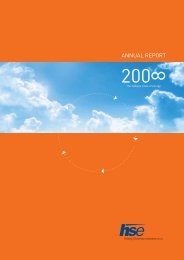Annual report - HSE
Annual report - HSE
Annual report - HSE
You also want an ePaper? Increase the reach of your titles
YUMPU automatically turns print PDFs into web optimized ePapers that Google loves.
4.5.7.4.2 Non-derivative financial liabilities<br />
Non-derivative financial liabilities comprise operating, financial and other liabilities.<br />
Financial liabilities are initially carried at fair value increased by the costs that are directly<br />
attributable to the transaction. After the initial recognition, financial liabilities are measured<br />
at amortised cost using the effective interest method.<br />
Among them the company records loans received with interest, liabilities to suppliers and<br />
liabilities to others.<br />
Loans received are initially recognised on the date of their settlement (payment), while<br />
other non-derivative financial liabilities are recognised on the trade date.<br />
The portion of long-term financial liabilities that falls due within less than a year after the<br />
cash flow statement date is disclosed under short-term financial liabilities.<br />
4.5.7.4.3 Derivatives<br />
Derivatives are used for the hedging of company’s exposure against interest rate, price and<br />
currency risks. The company has concluded interest and currency swaps as well as futures<br />
contracts for the purchase of electricity and emission coupons in the following years.<br />
These are financial instruments that do not require initial financial investment, while their<br />
value is changing due to change in interest rates, goods prices or foreign exchange rates.<br />
Derivatives are initially recognised at fair value, namely according to net principle, which<br />
means that the sole value of transaction concluded is not disclosed in financial statements.<br />
After the initial recognition, derivatives are measured at fair value, while the corresponding<br />
changes are considered in the following manner:<br />
• When a derivative is defined as hedging in case of exposure to changeability of cash<br />
flows that may be attributed to an individual risk related to recognised asset, liability or<br />
very probable envisaged transactions, which can affect the profit or loss, the successful<br />
portion of changes in fair value of derivative is recognised in comprehensive income<br />
and disclosed in risk hedging reserve. Unsuccessful portion of changes in the fair value<br />
of financial instrument is directly recognised in the income statement. The company<br />
shall discontinue prospectively the hedge accounting if the hedge no longer meets the<br />
criteria for hedge accounting, if the hedging instrument is sold, terminated or exercised.<br />
The accumulated profit or loss recognised in comprehensive income remains recorded<br />
in the hedging reserve until the envisaged transaction impacts the profit or loss. If the<br />
envisaged transactions cannot be expected any more, the amount recognised in other<br />
comprehensive income must be directly recognised in profit or loss. In other cases, the<br />
amount recognised as comprehensive income is transferred to profit or loss for the same<br />
period in which the protected item affects the profit or loss.<br />
• Effects of other derivatives, which are not determined as risk hedges in case of exposure<br />
to cash flow changeability or cannot be attributed to individual risk related to recognised<br />
asset or liability, are recognised in profit or loss.<br />
4.5.7.5 Inventories<br />
Inventories mostly include trading emission coupons (at the end of 2012, emission coupons<br />
were not in inventory).<br />
Inventories are carried at the lower of the two: historical cost or net realisable value.<br />
Historical cost includes cost that is composed of purchase price, import duties and direct<br />
costs of purchase. The purchase price is reduced by discounts received.<br />
<strong>Annual</strong> Report <strong>HSE</strong> 2012<br />
4 Financial Report of the company <strong>HSE</strong><br />
122<br />
If the prices of the items that are purchased anew in the accounting period differ from the<br />
prices of inventory items of the same class, the first-in first-out (FIFO) method is applied to<br />
decrease the quantities of inventories during the year.
















